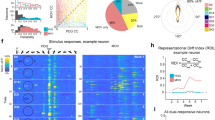Abstract
THE adult brain has a remarkable ability to adjust to changes in sensory input. Removal of afferent input to the somatosensory, auditory, motor or visual cortex results in a marked change of cortical topography1–10. Changes in sensory activity can, over a period of months, alter receptive field size and cortical topography11. Here we remove visual input by focal binocular retinal lesions and record from the same cortical sites before and within minutes after making the lesion and find immediate striking increases in receptive field size for cortical cells with receptive fields near the edge of the retinal scotoma. After a few months even the cortical areas that were initially silenced by the lesion recover visual activity, representing retinotopic loci surrounding the lesion. At the level of the lateral geniculate nucleus, which provides the visual input to the striate cortex, a large silent region remains. Furthermore, anatomical studies show that the spread of geniculocortical afferents is insufficient to account for the cortical recovery. The results indicate that the topographic reorganization within the cortex was largely due to synaptic changes intrinsic to the cortex, perhaps through the plexus of long-range horizontal connections.
This is a preview of subscription content, access via your institution
Access options
Subscribe to this journal
Receive 51 print issues and online access
$199.00 per year
only $3.90 per issue
Buy this article
- Purchase on Springer Link
- Instant access to full article PDF
Prices may be subject to local taxes which are calculated during checkout
Similar content being viewed by others
References
Kalaska, J. & Pomeranz, B. J. Neurophysiol. 42, 618–633 (1979).
Merzenich, M. M. et al. J. comp. Neurol. 224, 591–605 (1984).
Clark, S. A., Allard, T., Jenkins, W. M. & Merzenich, M. M. Nature 332, 444–445 (1988).
Sanes, J. N., Suner, S., Lando, J. F. & Donoghue, J. P. Proc. natn. Acad. Sci. U.S.A. 85, 2003–2007 (1988).
Sanes, J. N., Suner, S. & Donoghue, J. P. Expl Brain Res. 79, 479–491 (1990).
Robertson, D. & Irvine, D. R. F. J. comp. Neurol. 282, 456–471 (1989).
Cusick, C. G., Wall, J. T., Whiting, J. H. Jr & Wiley, R. G. Brain Res. 537, 355–358 (1990).
Gilbert, C. D., Hirsch, J. A. & Wiesel, T. N. in Cold Spring Harbor Symp. quant., Biol. 55, 663–677 (1990).
Kaas, J. H. et al. Science 248, 229–231 (1990).
Heinen, S. J. & Skavenski, A. A. Expl Brain Res. 83, 670–674 (1991).
Jenkins, W. M., Merzenich, M. M., Ochs, M. T., Allard, T. & Guic-Robles, E. J. Neurophysiol 63, 82–104 (1990).
Calford, M. B. & Tweedale, R. Nature 332, 446–448 (1988).
Donoghue, J. P., Suner, S. & Sanes, J. N. Expl Brain Res. 79, 479–491 (1990).
Devor, M. & Wall, P. D. Nature 276, 75–76 (1978).
Eysel, U. T., Gonzalez-Aguilar, F. & Mayer, U. Expl Brain Res. 41, 256–263 (1981).
Gilbert, C. D. & Wiesel, T. N. Nature 280, 120–125 (1979).
Gilbert, C. D. & Wiesel, T. N. J. Neurosci. 3, 1116–1133 (1983).
Rockland, K. S. & Lund, J. S. Brain Res. 169, 19–40 (1982).
Rockland, K. S. & Lund, J. S. J. comp. Neurol. 216, 303–318 (1983).
Martin, K. A. C. & Whitteridge, D. J. Physiol. 353, 463–504 (1984).
Gilbert, C. D. & Wiesel, T. N. Vison Res. 30, 1689–1701 (1990).
Ts'o, D., Gilbert, C. & Wiesel, T. N. J. Neurosci. 6, 1160–1170 (1986).
T'o, D. & Gilbert, C. J. Neurosci. 8, 1712–1727 (1988).
Gilbert, C. D. & Wiesel, T. N. J. Neurosci. 9, 2432–2442 (1989).
Yarbus, A. L. Biophysics, 2, 683–690 (1957).
Krauskopf, J. Am. J. Pyschol. 80, 632–637 (1961).
Crane, H. D. & Piantanida, T. P. Science 221, 1078–1079 (1983).
Ramachandran, V. S. & Gregory, R. L. Nature 350, 699–702 (1991).
Paradiso, M. A. & Nakayama, K. Vision Res. 31, 1221–1236 (1991).
Kanizsa, G. Organization in Vision. Essays on Gestalt Perception (Praeger, New York: 1979).
McKee, S. P. & Westheimer, G. Perception & Psychophysics 24, 25–62 (1978).
Fendick, M. & Westheimer, G. Vision Res. 23, 145–150 (1983).
Author information
Authors and Affiliations
Rights and permissions
About this article
Cite this article
Gilbert, C., Wiesel, T. Receptive field dynamics in adult primary visual cortex. Nature 356, 150–152 (1992). https://doi.org/10.1038/356150a0
Received:
Accepted:
Issue Date:
DOI: https://doi.org/10.1038/356150a0
This article is cited by
-
C1ql1-Bai3 signaling is necessary for climbing fiber synapse formation in mature Purkinje cells in coordination with neuronal activity
Molecular Brain (2023)
-
Cell-type-specific plasticity of inhibitory interneurons in the rehabilitation of auditory cortex after peripheral damage
Nature Communications (2023)
-
Induction of excitatory brain state governs plastic functional changes in visual cortical topology
Brain Structure and Function (2023)
-
Local neuroplasticity in adult glaucomatous visual cortex
Scientific Reports (2022)
-
Tuning instability of non-columnar neurons in the salt-and-pepper whisker map in somatosensory cortex
Nature Communications (2022)
Comments
By submitting a comment you agree to abide by our Terms and Community Guidelines. If you find something abusive or that does not comply with our terms or guidelines please flag it as inappropriate.



